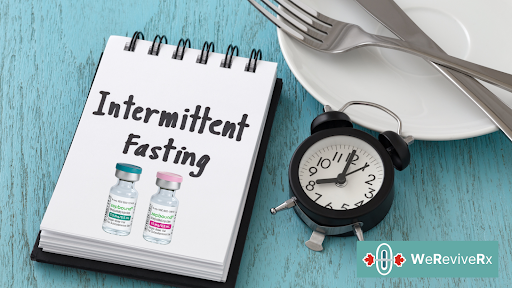Zepbound and Intermittent Fasting: Can You Combine Them?
Zepbound and Intermittent Fasting: Can You Combine Them?

Introduction
Zepbound already reduces appetite, helps you feel full longer, and promotes steady weight loss—but what happens when you combine it with intermittent fasting (IF)?
Many users ask whether it’s safe—or even beneficial—to do both. In this guide, we’ll explore whether Zepbound and intermittent fasting work well together, what science and real users say, and how to do it safely for optimal results.
What Is Intermittent Fasting?
Intermittent fasting is an eating pattern that alternates between periods of eating and fasting. Popular approaches include:
|
Method |
Eating Window |
|
16:8 |
8 hours eating, 16 hours fasting |
|
14:10 |
10 hours eating, 14 hours fasting |
|
OMAD |
One Meal A Day (not recommended for beginners) |
|
5:2 |
5 normal eating days, 2 reduced-calorie days |
The goal? Fat loss, blood sugar control, and improved insulin sensitivity.
Can You Combine Zepbound with Intermittent Fasting?

Zepbound already:
- Suppresses appetite
- Improves insulin sensitivity
- Slows digestion to help you feel full longer
Intermittent fasting adds:
- Clear eating/fasting structure
- Fewer eating opportunities = reduced calorie intake
- Potential metabolic and anti-inflammatory benefits
Many Zepbound users find it easier to fast because their hunger and cravings are already reduced.
Benefits of Combining Zepbound + IF






Tips for Doing It Safely
Here’s how to combine Zepbound and intermittent fasting the smart way:
1. Start with a gentle fasting window
Begin with 12:12 or 14:10. Once you’re adjusted to Zepbound and feel stable, you can try 16:8.
2. Don’t force fasting through nausea
If you’re early in Zepbound titration, your body may need fuel to stabilize digestion and blood sugar.

3. Stay hydrated
Zepbound and fasting both reduce food intake = lower water + electrolyte intake.

4. Break your fast with protein + fiber
This helps keep you full and supports muscle retention.


Sample Zepbound + 16:8 Schedule
|
Time |
What to Do |
|
8:00 AM |
Water, black coffee, or herbal tea |
|
10:00 AM |
Optional walk or light activity |
|
12:00 PM |
First meal (protein + fiber) |
|
3:00 PM |
Light snack if needed |
|
7:30 PM |
Final meal (balanced & satisfying) |
|
8:00 PM |
Begin fast |

Who Should Be Cautious?

- You’re still titrating up on Zepbound
- You feel dizzy, nauseous, or extremely fatigued
- You have a history of disordered eating
- You’re not getting enough calories or nutrients

Final Thoughts
Zepbound and intermittent fasting can work well together—especially for those who already feel less hunger and want to add more structure to their eating. Just be sure to listen to your body, prioritize nutrients, and ease in gradually.




